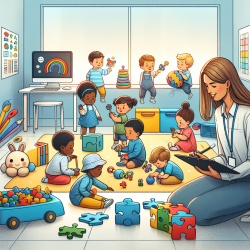In the world of speech-language pathology, creating engaging and effective therapy sessions for children is paramount. One innovative way to achieve this is by incorporating social robots with carefully designed gestures into your therapy toolkit. A recent study titled Designing Gestures of Robots in Specific Fields for Different Perceived Personality Traits provides valuable insights into how different types of robot gestures can influence their perceived personality traits and enhance interaction outcomes. Let's dive into the key findings and how you can leverage them in your practice.
Key Findings from the Study
The study conducted by Niu et al. (2022) explored the influence of robot gestures on perceived personality traits across four occupational fields: shopping reception, home companion, education, and security. The researchers categorized robot gestures into four types: deictic, iconic, beat, and metaphoric. Here's a summary of their findings:
- Deictic Gestures: These gestures indicate concrete objects or spaces and were found to enhance perceived competence and status.
- Iconic Gestures: These relate to concrete objects or events and also significantly improved perceived competence and status.
- Beat Gestures: Short, quick, and frequent hand and arm movements that enhance perceived sociality.
- Metaphoric Gestures: Used to visualize abstract concepts, though they appeared less frequently in the study.
Overall, introducing all types of gestures helped enhance perceived sociality, making the robots appear more outgoing and engaging.
Practical Applications for Speech Therapy
As a practitioner, you can use these findings to design more engaging and effective therapy sessions. Here are some practical applications:
- Use Deictic and Iconic Gestures: Incorporate robots that use deictic and iconic gestures to explain concepts or objects. This can make the therapy session more interactive and help children understand and retain information better.
- Add Beat Gestures for Engagement: Beat gestures can make robots appear more social and friendly, which is crucial for engaging children. Use robots with beat gestures during activities that require high interaction levels.
- Tailor Gestures to Context: The study found that the effectiveness of gestures varies by context. For example, beat gestures were more beneficial in shopping reception contexts but less so in home companion and education settings. Tailor the robot's gestures to the specific needs of your therapy session.
Encouraging Further Research
While the study provides a solid foundation, there is always room for further research. Consider conducting your own small-scale studies to observe how different gestures impact your specific group of children. Collect data on engagement levels, comprehension, and overall satisfaction to make data-driven decisions in your practice.
Conclusion
Incorporating social robots with thoughtfully designed gestures can significantly enhance the effectiveness of your therapy sessions. By leveraging the findings from the study, you can create more engaging and impactful interactions with your young clients. To read the original research paper, please follow this Designing Gestures of Robots in Specific Fields for Different Perceived Personality Traits.










